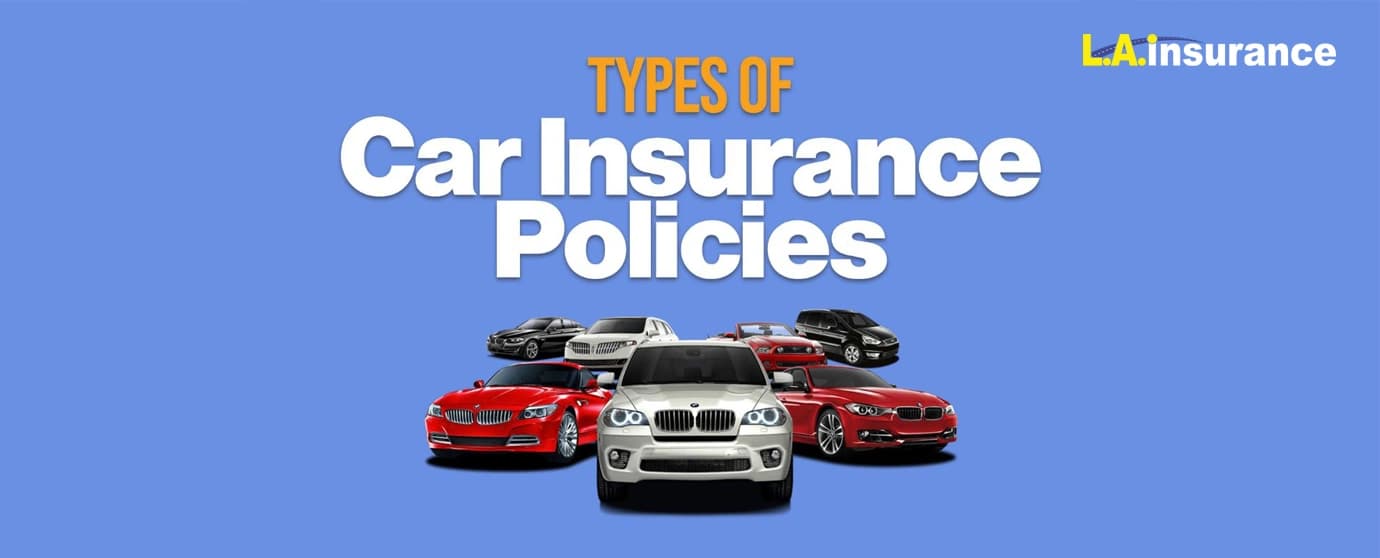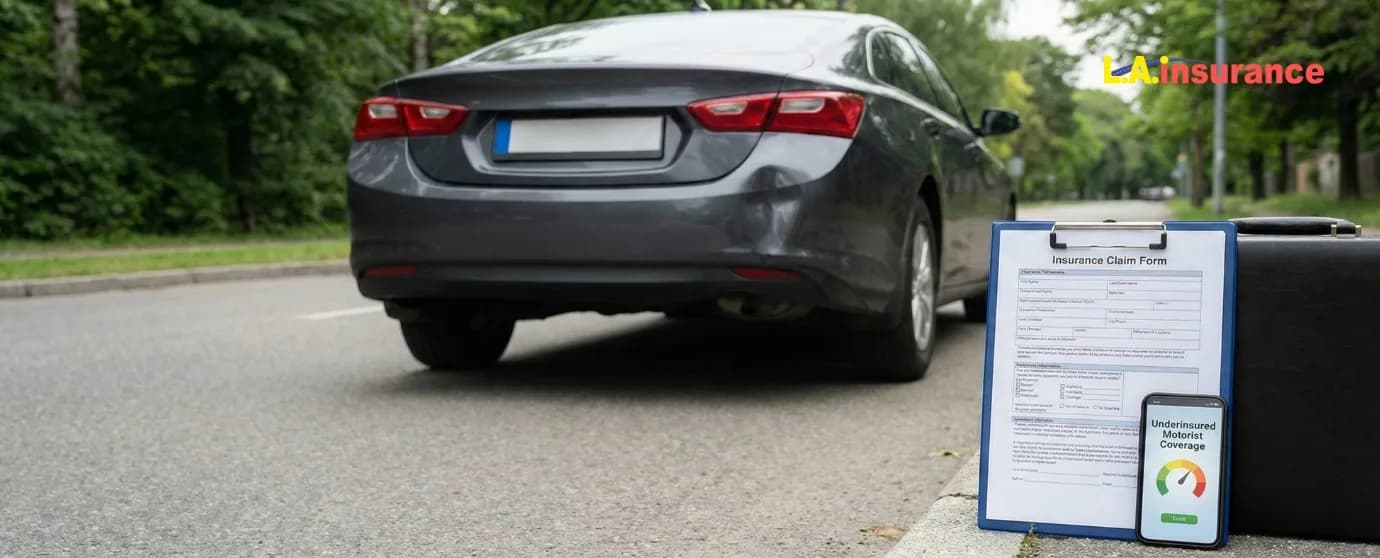
Publish Date: 19-08-2024
Auto Insurance
Last Updated: 19-01-2026
13 Types of Car Insurance Coverage
Auto insurance policies are made up of various coverage options to financially protect you if you get into an accident or damage your car. We feel that understanding different types of car insurance coverage for the first time can be overwhelming. But it doesn’t have to be. Because we’re here to make it easier for every one of you.
There are two main car insurance coverage types: Mandatory and Optional. Almost every state in the United States has to insure their car with minimum mandatory liability insurance coverage. However, this does not provide full safety for you and your vehicle. So, you need optional auto coverage as well. Optional insurance, such as comprehensive and collision, offers more protection for specific situations than mandatory coverage does.
In this article, we’ll explain different types of car insurance coverage and definition. We’ll cover everything from basic liability to optional add-ons like gap insurance, classic car insurance, and roadside assistance. Our aim is to simplify these options so you can choose the best car insurance coverage for you and your family. Let’s dive in.
13 Essential Car Insurance Coverage Types You Need to Know About
Here we’ll explain both mandatory and optional auto insurance coverages in detail. Mandatory types include liability insurance, personal injury protection, and uninsured motorist coverage. However, not all states mandate uninsured motorist coverage.
Besides, we will discuss different types of coverage for car insurance that are optional and offer extensive protection (full coverage car insurance) including collision coverage, and comprehensive coverage. Also, we will explain less common options such as roadside assistance, gap insurance, rental car coverage, and so on. Learning these auto insurance types will help you select the right coverage for your needs and budget.
Here is a list of 13 common car insurance coverage types:
- Liability Insurance Coverage
- Personal Injury Protection (PIP)
- Collison Coverage
- Comprehensive Coverage
- Medical Payment Coverage (MedPay)
- Uninsured Motorists Coverage
- Underinsured Motorists Coverage
- Gap Insurance
- Classic Car Insurance Coverage
- Roadside Assistant Coverage
- Rideshare Insurance Coverage
- Towing and Labor Coverage
- Rental Car Insurance Coverage
1. Liability Insurance Coverage
Auto liability insurance coverage is mandatory in most states except New Hampshire and Virginia. This type of auto coverage financially protects you if you’re at fault in an accident. The car insurance company will pay for any injuries, property damage, or even death that you cause to others in an accident. There are two components of liability car insurance:
1. Bodily Injury (BI): It covers the medical expenses, lost wages, pain and suffering, and legal fees for the other party if you’re at fault. For instance, if someone is injured in an accident you caused, this coverage will pay for their hospital bills and recovery.
2. Property Damage (PD): This auto coverage pays for damages to the other party’s vehicle or property including repairs or replacement of their vehicle, electronics, belongings inside the vehicle, or even damages to structures like fences or buildings.
Now, do you need to carry liability insurance? Yes. Everyone who owns and drives a car must have liability insurance. It not only legally requires, but it also protects you from financial loss if you cause an accident.
You might also want to know the coverage limit of auto liability insurance. Coverage limit means the maximum amount your insurance will pay which varies by state and insurer. A common minimum requirement is $25,000 per person for bodily injury, $50,000 per accident for bodily injury, and $25,000 for property damage (often written as 25/50/25). However, some states have higher minimums, and you can choose higher limits for more protection.
2. Personal Injury Protection (PIP)
Personal Injury Protection (short for PIP) is another major type of car insurance coverage. It pays for medical expenses and other costs if you’re injured in a car accident. This protection is legally required in “no-fault” states where your auto insurance company pays for injuries regardless of who caused the accident.
There are 12 no-fault states in the United States. You’ll need to have PIP car insurance coverage in Florida, Michigan, Hawaii, Kansas, Kentucky, Massachusetts, Minnesota, New Jersey, New York, North Dakota, Pennsylvania, and Utah. In these states PIP is mandatory. This makes sure you get immediate help after an accident and don’t have to wait for the fault to be determined. So, what does PIP cover? It covers the following:
- Medical expenses
- Death benefits (paid to your family)
- Funeral costs
- Lost wages (if you can’t work)
- Essential services (e.g., Housekeeping, Childcare)
However, it’s also important to remember that PIP won’t cover damage to your vehicle, injuries to other drivers (this is covered by liability insurance), or costs above your coverage limits. Besides, don’t confuse PIP with Bodily Injury (BI) protection. They are not the same. Bodily Injury liability coverage only protects you if you’re at fault. But PIP has your back regardless of fault.
In summary, adding PIP can help your family cover unforeseen expenses if you’re in a fatal car accident. It provides financial support for medical bills and essential services. For comprehensive protection, it’s worth considering life insurance.
3. Collison Insurance
Collision auto insurance is a type of car insurance coverage. Simply put, it helps you pay for damages to your vehicle after a collision. This includes accidents with another vehicle, hitting an object like a fence or tree, and single-car accidents.
Collision insurance covers the following:
- Collison with another vehicle
- Collision with an object
- Single-car accident
Collision insurance doesn’t cover the following:
- Damage that’s not related to driving
- Damage to another person’s vehicle
- Medical bills (for both parties involved)
Collision insurance coverage has deductibles and limits. A deductible is the amount you pay out of pocket before your insurance covers the rest. Common deductible amounts are $0, $500, or $1000. If you choose a lower deductible, it will increase your premiums. The opposite happens for the higher deductible.
Now who needs collision coverage? If you own a new or expensive car, you should register it under the collision coverage policy. It ensures your vehicle can be repaired or replaced after an accident. Even if it’s optional in your state, having collision insurance provides financial security and peace of mind.
4. Comprehensive Coverage
Comprehensive auto insurance covers damage to your vehicle that is not caused by a collision. It is often referred to as “other than collision” coverage. This car insurance coverage type provides a shield against theft, natural disasters, and vandalism. However, it doesn’t cover business vehicles.
So, here's what your comprehensive auto insurance covers:
- Vandalism
- Fire, explosions
- Accidents with animals (e.g., hitting deer)
- Storm damage, hail, wind, floods, Lightning, earthquakes
- Falling trees
Here’s when you need comprehensive coverage protection:
- If you have a new or valuable car
- If you live in an area prone to natural disasters
- If your car is at risk of theft or vandalism
It’s also important to remember that comprehensive coverage is neither the same as full coverage nor collision coverage. Full coverage car insurance typically includes both collision and comprehensive insurance. So, purchasing affordable full coverage auto insurance can enhance your protection more extensively. Also, comprehensive coverage is not similar to collision coverage as well. Because it protects from non-collision-related damage.
5. Medical Payment Coverage (MedPay)
Medical Payment Coverage, or MedPay, is an optional auto insurance coverage that helps pay for medical expenses resulting from a car accident, regardless of who is at fault. MedPay ensures that you and your passengers receive necessary medical care after an accident.
What Does MedPay Cover?
- Doctor visits
- Hospital Visits
- Nursing Services and Care
- Ambulance and EMT
- Funeral Expenses
- Surgery
- Extras
- Dental Procedure
MedPay coverage limits often range between $1000 and $10000, depending on your state and insurer. This coverage can be quite beneficial for covering out-of-pocket medical bills that your health insurance may not fully cover.
6. Uninsured Motorists Coverage
Uninsured Motorists Insurance (UM) is a type of car insurance coverage that protects you if you’re hit by a driver who has no car insurance. This auto insurance coverage type steps in when the at-fault driver cannot pay for your damages. That being said, not all states require this coverage. For instance, in Illinois state, drivers must have both uninsured and underinsured motorist coverage. But states like Massachusetts and South Carolina require only uninsured motorist coverage.
Here's what uninsured motorists insurance covers:
- Pays for medical bills if you or your passengers are injured.
- Compensates for income lost due to accident-related injuries.
- Covers non-economic damages like pain and emotional distress.
- Pays for repairs to your car if the at-fault driver is uninsured.
So, should you register your car under uninsured motorist coverage? Well, you don’t want to be financially burdened by another driver’s lack of insurance, right? So, it’s worth picking. Besides, according to the Insurance Information Institute, about 15.4% of motorists, or 1 in 7 drivers, were uninsured in 2023. That’s why this coverage can be key in protecting yourself from unexpected financial burdens.
When it comes to uninsured motorists' coverage limits, it matches your liability coverage limits. For example, if you have $100,000 in bodily injury liability coverage, your UM coverage will likely be the same. Having adequate UM coverage is necessary to ensure you’re fully protected.
7. Underinsured Motorists Coverage
UIM stands for Underinsured Motorists Coverage. It helps you if you get hit by a driver whose insurance doesn't cover all of your losses. So, this coverage kicks in when the at-fault driver’s insurance falls short. UIM has two components: UIM Bodily Injury Coverage and UIM Property Damage Coverage. This means UIM covers medical bills and costs to repair and replace your vehicle. However, it may also offer reimbursement for income lost due to accident-related injuries.
UIM is required if you’re a resident of one of the following states:
- Connecticut
- Maine
- Kansas
- Maryland
- Minnesota
- Nebraska
- North Carolina
- North Dakota
- Vermont
Besides, it’s important to note that UIM coverage doesn’t apply to hit-and-run accidents, which are usually classified under uninsured motorists' coverage. In some states, you may also need collision coverage to be fully protected. Always check with your insurance agent to make sure you have the right coverage plan.
8. Gap Insurance
Guaranteed Asset Protection, short for GAP, is one of the additional types of car insurance coverage. This helps cover the “gap” between what you owe on your car loan or lease and the car’s Actual Cash Value (ACV) in the event of a total loss. This situation often arises because a new car’s value depreciates quickly, sometimes faster than you pay down the loan.
Gap Insurance Covers the Following:
- Total Loss from Accidents: If your car is totaled in an accident, gap insurance pays the difference between the car’s ACV and the remaining balance on your loan or lease.
- Theft: If your vehicle is stolen and not recovered, gap insurance covers the gap between the ACV payout and what you still owe.
Here’s When You Should Consider Gap Insurance:
- Especially useful if you have a high loan balance or lease.
- Ideal for cars that depreciate quickly.
- If you made a small down payment, gap insurance helps bridge the difference if the car’s value drops below what you owe.
To sum up, though Gap insurance coverage isn’t mandatory, it can be a wise choice for you if you have leased, financed, or leased vehicles. It provides financial protection so that you’re not stuck anymore paying off a car that you no longer own due to an accident or theft. So, you can consider adding Gap Insurance if your car’s depreciation rate outpaces your loan repayments.
Learn More About GAP Insurance: What is GAP Insurance?
9. Classic Car Insurance Coverage
Your standard auto insurance may not fully cover a collectible vehicle (e.g., an antique car). So, it’s best if you have Classic Car Insurance Coverage. It’s a specialized type of auto insurance designed for antique, vintage, and collectible cars. This coverage is different from standard auto insurance due to its unique value and usage of classic cars.
A classic car insurance policy covers the following:
- Provide comprehensive and collision coverage
- Provide the minimum liability requirements of your present state
- Pays the agreed-upon value of the car in the event of a total loss.
- Covers the cost of spare parts and accessories.
- Allows for repairs by specialists familiar with classic cars.
- Provide roadside assistance such as winching, towing to a repair facility, battery jump starts, wheel delivery, lockouts, flat tire changes, and so on.
- Covers vehicles under restoration.
To qualify for classic car insurance, you must meet the following criteria:
- The classic car can’t be used every day like a regular car.
- Must typically be at least 20-25 years old.
- The classic should be secured, and an enclosed garage is required.
- The vehicle must be in good or restored condition.
- In some states, clean driving is often required.
- Some insurers may require membership in a classic car club.
- Mileage limit is usually restricted to around 5,000 miles.
In short, classic car insurance is worth it for owners who want to protect their prized vehicles. It offers coverage options that standard car insurance policies do not.
10. Roadside Assistance Coverage
Roadside Assistance Coverage is an optional add-on to your car insurance policy. It provides help if your vehicle breaks down while you’re on the road. You can have peace of mind knowing that you can call emergency services at any time and from anywhere.
Here's what usually Roadside Assistance insurance covers:
- Towing: If your car breaks down and can’t be fixed on the spot, these coverage options help you transport your vehicle to a repair facility.
- Battery Jump Start: Roadside assistance can provide you with a jump start if the battery dies.
- Flat Tire Change: To get you back on the road, a professional repairer will be sent who will replace the flat tire with your spare.
- Lockouts: Assistance is provided if you lock yourself out of your vehicle.
- Winching: Unfortunately, if you run off the road and get stuck in the snow, mud, or a ditch, Roadside Assistance can help you get your vehicle out of it.
- Fuel Delivery: Providing enough fuel to reach the nearest gas station.
The cost of Roadside Assistance Coverage varies. But on average, it can cost anywhere from $10 to $100 per year, depending on the insurance provider and the level of coverage chosen. Adding this car insurance coverage type can be a cost-effective way to ensure you’re always prepared for unexpected vehicle issues.
11. Rideshare Insurance Coverage
It's a specialized car insurance coverage type that protects you when you drive your personal vehicles for ridesharing services like Uber and Lyft. It fills the coverage gaps between your personal auto insurance policy and the commercial policy provided by the rideshare company.
Rideshare Insurance typically covers:
- Period 1: When the app is on, and you’re waiting for a ride request. Your personal auto insurance might not cover you at this time, and the insurance provided by the rideshare company only covers a certain amount.
- Period 2: When you have accepted a ride and are on your way to pick up the passenger. Rideshare insurance covers you with additional liability coverage.
- Period 3: When the passenger is in your car. Rideshare insurance can cover liability, collision, and comprehensive claims.
This auto coverage type also applies to delivery services like Uber Eats and DoorDash. This means if you’re delivering food or packages, your rideshare insurance can protect you during all phases of the delivery process.
12. Towing and Labor Coverage
Towing and labor coverage is an optional add-on to your auto insurance policy. It helps cover the costs associated with towing your vehicle and certain labor expenses if your car breaks down or becomes undrivable.
Towing and labor coverage typically covers:
- Towing: The cost to tow your vehicle to a repair facility.
- Labor Costs: Expenses for services performed at the breakdown site, such as battery jump-start, flat tire changes, fuel delivery, and minor mechanical repairs.
So, do you need towing and labor coverage? Well, unless you have roadside assistance coverage, you’ll have to pay for the expenses of towing vehicles and related labor costs. Roadside assistance has a bit more comprehensive coverage compared to this auto coverage option. This is why you should only choose what is best suited for you.
13. Rental Car Insurance Coverage
Rental car insurance coverage is generally optional. It protects you when driving a rental vehicle. It can help cover damage or loss to the rental car, your liability to others, and medical bills in case of an accident.
Here are four rental car insurance coverage types:
- Collison Damage Waiver (CDW): Covers damage to or theft of the rental car.
- Supplemental Liability Insurance: Covers damage you cause to other people or property.
- Personal Accident Insurance: Covers medical expenses for you and your passengers.
- Personal Effects Coverage: Protects your belongings if they are stolen from the rental car.
Generally, your personal car insurance often extends to rental cars and covers collision, liability, and comprehensive claims. The cost of rental car insurance can be anywhere from $30 to $60 per day. However, it can vary by insurers and states.
Here’s who should get rental car insurance:
- Travelers Without Personal Auto Insurance: If you don’t have your own car insurance, purchasing rental coverage is necessary.
- People with Limited Coverage: If your personal auto policy has low coverage limits, you can get additional rental car insurance for extra protection.
- Business Travelers: If your personal auto insurance policy doesn’t cover business use of a rental car, additional coverage is a good idea.
The Bottom Line
Understanding different types of car insurance coverages is necessary for protecting yourself and your vehicle. From state-mandated liability insurance to comprehensive coverage, each type offers unique benefits. Evaluate your needs and choose the right coverage to make sure you’re fully protected on the road. Whether it’s mandatory or optional, the right insurance can save you from sudden financial loss and provide you with peace of mind. You can get your desired automobile insurance coverage from our affordable insurance agency with a few clicks.
Frequently Asked Questions on Different Types of Coverage for Car Insurance
1. What Are the Types of Car Insurance Coverage Required by the Law of Washington?
In Washington, drivers must have auto liability insurance with a minimum of $25,000 for bodily injury per person, $50,000 for per accident, and 10,000 for property damage. Personal Injury Protection (PIP) and Uninsured/Underinsured Motorists coverage are optional but must be offered by insurers. Drivers are allowed to reject this optional coverage in writing if desired.
2. What Are the Different Types of Car Insurance Coverage in Michigan?
In Michigan car insurance coverage includes mandatory Personal Injury Protection (PIP), Property Protection Insurance (PPI), and Residual Liability Insurance (Bodily Injury and Property Damage). Optional coverages are collision, comprehensive, uninsured/underinsured motorists, and medical payments (MedPay). Each type offers specific protection. Learn More: Michigan Auto Insurance Requirements.
3. Does My Car Insurance Cover Drunk Driving Accidents?
Auto insurance can cover drunk driving accidents, but it depends on the policy and the state laws. For example, in Michigan, if you cause an accident while driving under the influence, your liability coverage may pay for damages to other parties. However, insurance companies might deny claims for your injuries or damages to your vehicle, as driving intoxicated is illegal. Also, after a DUI conviction, you may be required to get SR-22 insurance for three years. which is typically more expensive, and not all insurance providers offer this option. You can speak to our insurance agent who specializes in providing SR-22 insurance to understand this more extensively.
4. Is Comprehensive Insurance the Same as Full Coverage?
No, both are different. Comprehensive coverage protects non-collision-related damages like theft, vandalism, and natural disasters. On the other hand, full coverage car insurance typically includes liability, collision, and comprehensive coverage combined.
5. Do I Need Collision Insurance If I Have Comprehensive Coverage?
You’ll need both. Comprehensive and collision coverage covers different types of incidents. Collision covers accidents with other vehicles or objects. However, comprehensive protects you from non-collision-related incidents such as theft, vandalism, and natural disasters.
6. Is Personal Injury Protection (PIP) Required in All States?
No, PIP is only mandatory in no-fault states but optional in others. 12 states, including Florida, Hawaii, Kansas, Kentucky, Massachusetts, Michigan, Minnesota, New Jersey, New York, North Dakota, Pennsylvania, and Utah, are no-fault states and require PIP. This type of car insurance coverage provides financial expenses and lost wages, regardless of who is at fault in an accident.
Tag :
fast car insurance
cheap car insurance
Auto insurance








